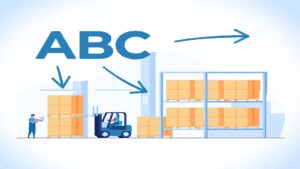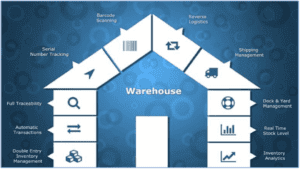In the ever-evolving arena of supply chain management, businesses are unceasingly in pursuit of methods to optimize operations and elevate efficiency. Public warehousing has emerged as a robust solution, empowering companies with the adaptability and expertise required to adeptly manage inventory and distribution. This blog delves into the core functionality of a savvy public warehousing system, uncovering the indispensable components that must not be overlooked.
Unraveling Public Warehousing
Public warehousing, also acknowledged as third-party warehousing, revolves around entrusting storage and distribution needs to a specialized provider. These providers curate shared facilities, affording multiple businesses the space to store their products. This approach offers a cost-effective avenue for companies aiming to channel their focus towards core competencies while simultaneously capitalizing on professional logistics and warehousing services.
Key Features of an Intelligent Public Warehousing System
Sophisticated Inventory Management:
- Product Segmentation: The system should facilitate businesses in categorizing inventory based on attributes like SKU, size, type, and demand for streamlined organization and retrieval.
- Lot and Batch Tracking: In-depth inventory management includes the ability to trace lots and batches – an imperative function for industries dealing with perishables, pharmaceuticals, or products governed by regulatory compliance.
Real-Time Glimpse of Inventory:
- Live Inventory Tracking: A dynamic public warehousing system ought to provide real-time visibility into inventory levels, enabling businesses to monitor stock and incoming shipments.
- Order Status Updates: Businesses should be empowered to track order statuses in real time – from order initiation to final delivery – enhancing overall customer satisfaction.
Unlocking Inventory Management Efficiency with ABC Analysis:
- The ABC analysis method stands as a valuable asset for businesses seeking optimization. This technique classifies inventory items into three categories based on their value: A (high-value), B (moderate-value), and C (low-value). This categorization enables resource allocation, demand forecasting, cost reduction, and improved working capital management. By ranking items by value contribution, businesses can streamline their inventory practices and enhance operational performance, leading to increased profitability.

Elevated Order Fulfillment:
- Optimal Order Picking: The heart of efficient warehousing is order fulfillment. A smart public warehousing system should integrate features enabling swift and precise order picking, packing, and shipping. Automation technologies like robotics and barcode scanning can magnify this process.
- Wave Picking: Streamlining the picking process, wave picking groups similar orders, curtailing unnecessary movement within the warehouse.
Automation and Robotics Revolution:
- Robotic Picking and Packing: Robotic automation can remarkably enhance efficiency by mechanizing repetitive tasks, diminishing human errors, and expediting order fulfillment.
- Automated Guided Vehicles (AGVs): AGVs streamline goods movement within the warehouse, minimizing manual handling and optimizing floor space.
Space Utilization at Its Zenith:
- Maximized Space Utilization: Space optimization is pivotal in public warehousing. A smart system should employ algorithms to arrange products within the warehouse effectively, minimizing wastage.
Harmonious Multi-Channel Integration:
- Omni-Channel Compatibility: In the multifaceted world of retail, a smart public warehousing system should seamlessly blend with various sales channels, encompassing e-commerce platforms and physical stores.
- Order Consolidation: For businesses catering to diverse sales channels, the ability to amalgamate orders from distinct origins into a solitary shipment proves invaluable for cost-effective fulfillment.
Unified Transportation Management:
- Integrated Transportation Management: Flawless coordination between warehousing and distribution is paramount. This functionality ensures orders are routed optimally, considering delivery timeframes and carrier availability.
 Predictive Insights and Demand Projection:
Predictive Insights and Demand Projection:
- Predictive Analytics: Forecasting demand patterns and trends using predictive analytics assists businesses in anticipating fluctuations and adjusting inventory levels accordingly.
- Replenishment Planning: Leveraging demand forecasting, the system automates replenishment orders, maintaining optimal inventory levels.
Lucid Reporting, Insights, and Analytics:
- Informative Dashboards: The system should present customizable dashboards for visual insights into key performance indicators (KPIs) like inventory turnover and order accuracy.
- Data-Driven Decision Making: Detailed reports and analytics empower businesses to make well-informed decisions, identify improvement areas, and hone supply chain strategies.
Competitive modern market
In the swiftly evolving business panorama, the functionality of a smart public warehousing system emerges as the linchpin to streamline supply chain operations. The fusion of real-time visibility, advanced order fulfillment, space optimization, transportation management, predictive insights, and robust reporting enables businesses to attain efficiency, reduce costs, and deliver exceptional customer experiences. Embracing these pivotal functionalities empowers enterprises to leverage public warehousing’s potential for growth and triumph in the fiercely competitive modern market.
Navitrans Warehouse Management System (ERP, WMS & TMS)
With Navitrans Logistics Software, businesses can effectively manage their warehouse- and transport management operations, including order processing, graphical planning board, route optimization, portals and control tower. The software provides real-time supply chain visibility into warehouse and transport operations and helps automate various warehousing and transportation tasks, leading to improved productivity and optimal performance. Navitrans is based on Microsoft Dynamics 365 Business Central.
Author is Harry Luijk – Logistics & Supply Chain Professional – CCO at Navitrans a Valsoft Aspire Software Company | Partner at Merlyn Consult.


